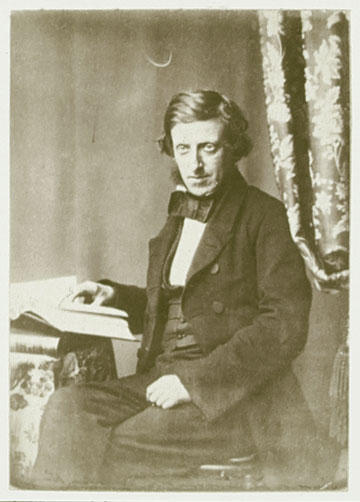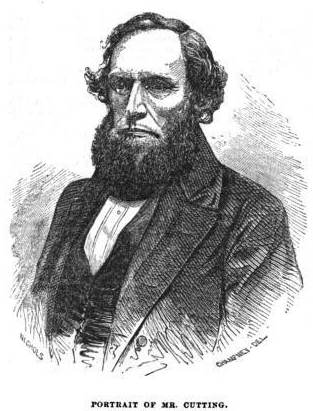<Back to Index>
- Inventor Frederick Scott Archer, 1813
- Inventor James Ambrose Cutting, 1814
PAGE SPONSOR

Frederick Scott Archer (1813 – 1 May 1857) invented the photographic collodion process which preceded the modern gelatin emulsion. He was born in either Bishop's Stortford or more likely Hertford in the United Kingdom and is remembered mainly for this single achievement which greatly increased the accessibility of photography for the general public.
Scott Archer was the son of a butcher from Hartford who went to London to take an apprenticeship as a silversmith. Later, he became a sculptor and found calotype photography useful as a way of capturing images of his sculptures. Dissatisfied with the poor definition and contrast of the calotype and the long exposures needed, Scott Archer invented the new process in 1848 and published it in The Chemist in March 1851, enabling photographers to combine the fine detail of the daguerreotype with the ability to print multiple paper copies like the calotype. In publishing his discovery, he did so knowingly without first patenting it, giving it as a gift to the world.
He later developed the ambrotype jointly with Peter Fry.
He died impoverished, as since he did not patent the collodion process he made very little money from it. An obituary described him as "a very inconspicuous gentleman, in poor health."
His family received a gift of £747 after his death, raised by public subscription, and a small pension was also provided to support his three children after the death of their mother.
The Royal Photographic Society has a small collection of Scott Archer's photographs, some are also held in the Victoria and Albert Museum.
Archer is buried at Kensal Green Cemetery in London, W10.

James Ambrose Cutting (1814 – 1867) was an American photographer and inventor, sometimes called the inventor of the Ambrotype photographic process.
He grew up in poverty on a farm in Haverhill, NH. At age 28, he
invented a new type of beehive in 1842, and on the money from selling
his patents moved to Boston.
To create an ambrotype, the photographer sensitized a polished plate of glass by the wet plate collodion process and exposed the plate in a camera to produce a negative image. The wet plate collodion process was invented just a few years before by Frederick Scott Archer and widely used for glass negatives, but in an ambrotype the collodion image is used as a positive, instead of a negative.
When dry, the glass plate was then backed either with black paint, metal, cloth or paper; this black backing made light areas of the negative appear darker, turning the negative image into a positive. Some ambrotypes were made with ruby or dark green glass to simulate the effect of a backing without using one. Ambrotypes often were hand colored, most commonly with dabs of red paint on the cheeks of the sitter. They were housed in wood or thermoplastic cases (also called 'Union cases'), like the daguerreotype photographs with which they are often confused; an ambrotype is easily distinguished from a daguerreotype because its surface is not reflective, as daguerreotype surfaces are. Ambrotypes were most popular during the mid to late 1850s but continued to be available through the 1890s.
In 1854, Cutting took out three patents relating to the process of
creating images on glass using the wet plate collodion process. While
Cutting is sometimes referred to as the inventor of the ambrotype, his
three photographic patents of 1854 refer only to improvements in the
process, rather than the idea of the collodion positive itself.
Ambrotypes (black backed collodion positives) are reported to have been
made at least as early as 1852 by Frederick Scott Archer.
Patent Numbers 11,213, 11,266 and 11,267: Awarded to James Ambrose Cutting of Boston, Massachusetts, in 1854 for creating collodion positive photographs on glass. The first and second of these patents refer to the chemicals & handling used in the collodion process, while the third describes a method for sealing finished collodion images beneath a layer of glass using balsam - the so-called Cutting's Patent Ambrotype.
Patent Number 19,626: In 1858, James Ambrose Cutting & Lodowick
H. Bradford of Boston, Massachusetts, were awarded a patent for
improvements in Photolithography. They defined a process of creating a
very durable photographic picture on a lithographic limestone printing
plate.
In 1859, he and Henry D Butler first opened their Boston Aquarial Gardens, a public aquarium on Bromfield Street, which they later moved to 240 Washington Street. His partner wrote the book The Family Aquarium which published in 1858 was one of the first books written in the United States solely about the aquarium.
The first advertisements for the Grand aquariums at the Boston Aquarial Gardens appeared in the April 12th, 1859, edition of the Boston Post. "This magnificent display of one of the most fascinating phenomena of nature is now open for public exhibition," announced the Boston Post. "These Ocean Conservatories are filled with rare marine animals imported and collected exclusively for this Establishment. They present us with a perfect and striking illustration of Life Beneath The Waters." The facility was eventually purchased by P. T. Barnum, under whose management ("Barnum's Aquarial Gardens") it became more of a show hall than a serious scientific establishment; "Madame Lanista," who wrestled with snakes, was a typical attraction of this period. The property eventually became the Theatre Comique in 1864 - 67.
Distraught over the conversion of the Aquarial Gardens into an amusement hall, Cutting suffered a nervous collapse, from which he never recovered; he died in August 1867 in an insane asylum in Worcester, MA. Article in New York Times: 'Death of an Inventor'.